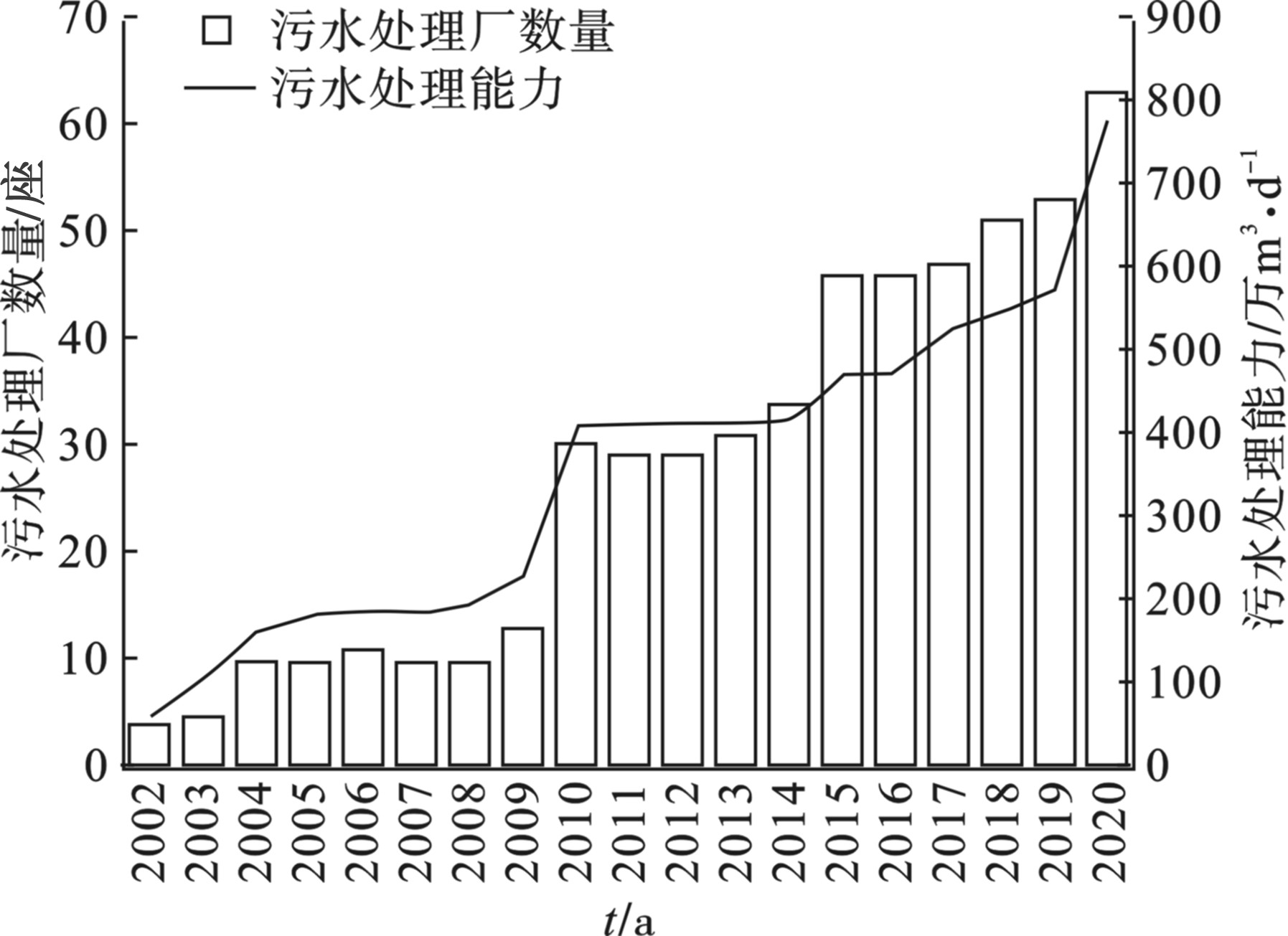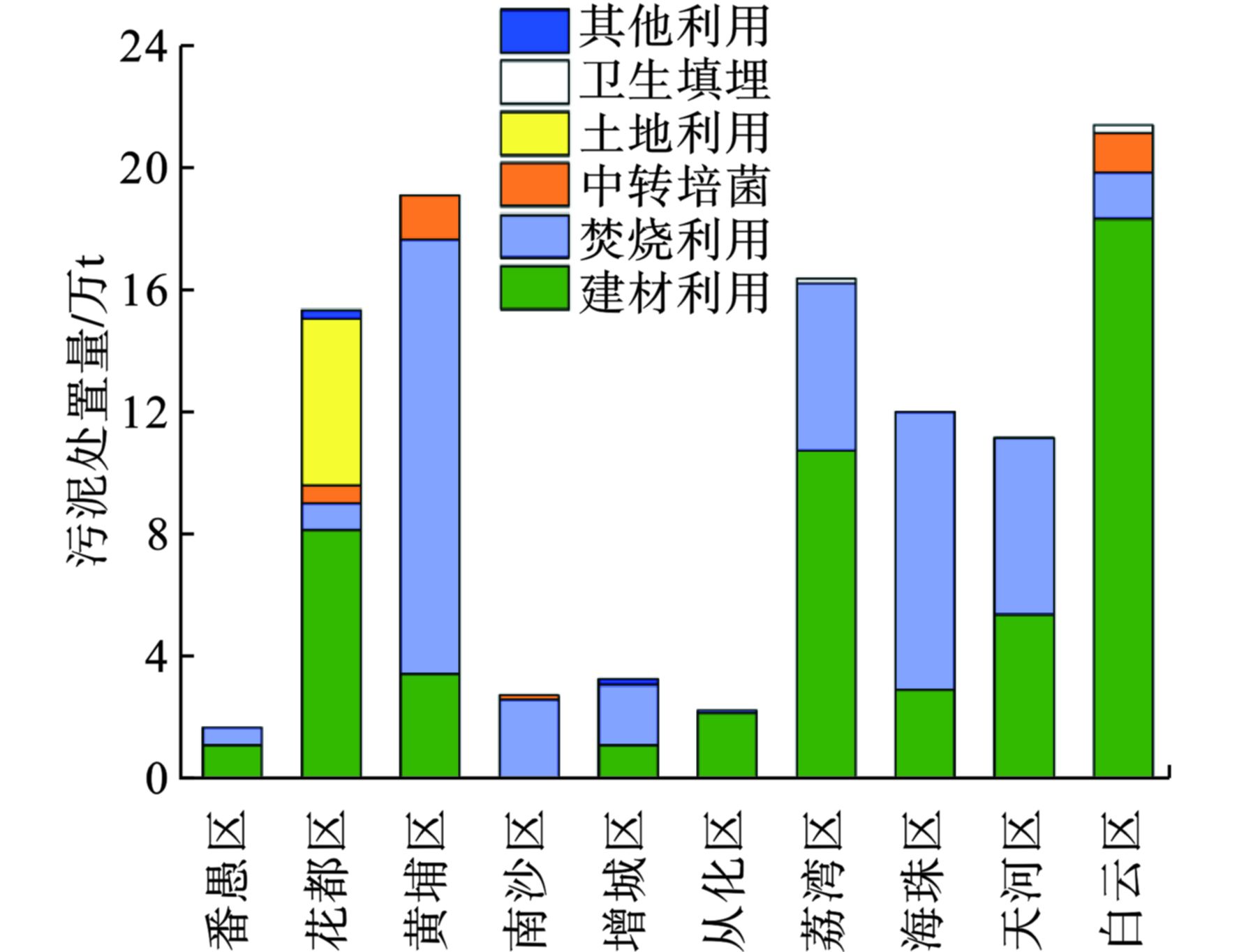-
近年来,由于二氧化碳等温室气体排放导致全球极端天气变化的问题越来越被人所关注[1]。为了应对气候变化,2020年9月,习近平总书记在第七十五届联合国大会上承诺我国二氧化碳排放力争于2030年前达到峰值,2060年实现碳中和目标。因此,各个行业都面临巨大的碳减排压力,寻求正确的减排措施刻不容缓。
我国是碳排放大国,2019年我国二氧化碳排放总量约115亿t,占全球的30%,非二氧化碳温室气体排放约24亿t二氧化碳当量,碳汇10亿t[2-4]。其中污水处理行业碳排放量占总排放量的1%~2%,是不可忽略的减排领域[5]。随着城镇化的推进和污水处理设施的完善,我国城镇污泥产生量巨大,截至2019年底,我国城镇污泥年产量达3 923万t(80%含水率)[6]。污泥若不妥善处置,随意抛弃,会带来二次污染问题,为此国家加强了污泥处理处置工作[7]。
污泥处理和处置工艺主要包括好氧发酵、厌氧发酵、干化、填埋、土地利用和污泥焚烧等[8],污泥处理处置方式不同,单位质量的污泥产生的碳排放不同。因此,本文以广州市为例,通过搜集污泥处理处置数据,计算各种处理途径带来的碳排放量,根据以往数据,构建多元回归模型,预测未来污泥处置的碳排放量,为污泥处理行业碳减排及“双碳”目标的实现提供合理化建议。
-
文章所采用的数据来源于中国住房和城乡建设部、国家统计局、广州市水务局和广州市生态环境局,收集了广东省和广州市历年的污泥产生量、污水处理厂数据以及广东省各地区的区域特征发展的相关数据。
-
二氧化碳当量用作比较不同温室气体排放的量度单位,一种气体的二氧化碳当量为这种气体的吨数乘以其产生温室效应的指数。
污泥处置引起的直接和间接温室气体排放主要为
CO2、CH4 和N2O ,温室效应指数分别为1、5和298,最后将其转换为二氧化碳当量。分为5种不同的技术路线,包括厌氧消化+土地利用(路线1)、好氧堆肥+土地利用(路线2)、卫生填埋(路线 3)、污泥焚烧(路线4)和建材利用(路线5)[9-12]。 WEI et al[9]认为上述5条技术路线总的二氧化碳当量计算,见式(1~5):式中,
TotalCO2-eq 为每种技术路线产生的总二氧化碳当量,CO2-eq ofCH4Emission 为厌氧消化过程中以及土地利用过程中有机物残留产生的CH4 ,CO2 Emission 包括由CH4 燃烧产生的CO2 (定义为CO2-CH4 )和由土地利用中的有机物残留、填埋场和消化池产生的生物二氧化碳(定义为CO2-biogenic ),CO2-avoided 是技术路线减少排放的CO2 ,CO2-eq1 为污泥好氧堆肥过程中排放的CO2 ,CO2-electricity 和CO2-coal 为好氧堆肥过程中消耗的电力和煤的CO2-eq ,CO2-diesel 是指化石燃料燃烧产生的CO2 ,CO2-CH4 为卫生填埋过程产生的CH4 产生的CO2 ,CO2-CH4,N2O 为污泥焚烧和建材利用产生的CH4 和N2O 产生的CO2 。经过计算,5种路线总的二氧化碳当量分别为960、731、1 587、2 341和1 240 kg CO2-eq。
-
在《水污染防治行动计划》《广东省水污染防治行动计划实施方案》《南粤水更清行动计划》等法规条例的推动下,广州市城市污水处理厂、污水处理和污泥产生的数量和规模上都有了很大的提升。截至2020年底,广州市的污水处理厂已建成63座,污水处理能力达到了774 万m3/d,年污泥产生量为77.34 万t。广州市各年度污水处理厂污水处理量和污泥产生量,见图1。
图1可知,从2002年开始全市污水处理厂及其污水处理量都在不断增加,污水处理能力从62万m3/d到2020年774万m3/d,增加了1 200.5%。
广州市2006年以来全市城镇污泥产生量,见图2。
图2可知,广州市城镇污泥产生量在平均值81.54万t上下不断变化,波动较大,并且2011年达到最大值152 万t,2018~2020年分别产生81、105.21和104.78万t,因此,如此巨大的污泥如果处理方式不当,会带来比较大的碳排放问题,影响“双碳”目标的实现。
-
广州市的污泥处置方式已经从最开始的简易填埋和堆肥发展到了如今多元化处理[13]。2020年广州市城镇污泥的处置主要为建材利用(制砖、制陶粒和水泥窑协同处理)、焚烧利用、中转培菌、土地利用(堆肥、厌氧消化和制营养土)和卫生填埋等5种方式。根据广州市水务局公开的资料,2020年广州市城镇污泥处理量为104.78万t,其中建材利用、焚烧利用、中转培菌、土地利用以及卫生填埋分别为53.13、41.84、3.48、5.44及0.42万t,其他0.47万t。城镇各种污泥处置方式占比,见表1。
整体来看,广州市的城镇污泥主要是以建材利用(50.7%)和焚烧利用(39.93%)为主,一定程度上实现了废弃物资源化利用。广州市各区污泥处置量及处置方式,见图3。
白云区、黄浦区和荔湾区污泥处理量最大,分别为21.28、19.00和16.29万t。各区均以建材利用和焚烧利用为主,其中以建材利用为主要处理手段的为番禺区、花都区、从化区、荔湾区和白云区,以焚烧利用为主要处理手段的是黄浦区、增城区、南沙区、海珠区和天河区。
-
由上述数据可知,广州市污泥处置过程中的碳排放主要集中在以下4种处置方式过程中,土地利用、卫生填埋、焚烧利用和建材利用。本文中将厌氧消化+土地利用(路线1)、好氧堆肥+土地利用(路线2)的总的二氧化碳当量均值作为土地利用过程中产生的二氧化碳当量,4种处置方式排放的二氧化碳当量分别为846、1587、2341和1240 kg CO2-eq [10-12],可见污泥土地利用处置碳排放量最少。
4种处置方式污泥产生的二氧化碳当量乘以对应的污泥产生量,得到广州市及各区2020年4种污泥处置方式产生的温室气体排放量,见表2。
表2可知,广州市城镇污泥处置二氧化碳当量约为1 690.97×106 kg CO2-eq,建材利用、焚烧利用、土地利用和卫生填埋4种处置方式的碳排放分别为658.78×106 kg CO2-eq、979.50×106 kg CO2-eq、46.05×106 kg CO2-eq和6.64×106 kg CO2-eq,其中黄浦区、白云区和荔湾区碳排放最多,这是由于这些区域污泥焚烧利用相对最多。
-
为了进一步预测广州市未来几年污泥处置碳排放量,首先需要对其污泥产量进行预测。根据李乔洋等研究[13],城镇污泥产量与城镇化率和地区生产总值有明显的相关性,另外,彭洁[14]也发现城镇污泥产量也与城镇污水处理率相关性较强。因此,本研究选取镇化率、地区生产总值和城市污水处理率作为自变量,以各年度城镇污泥产量为因变量,构建多元线性回归模型对未来广州市城镇污泥产量进行预测。建立多元回归方程[14],见式(6):
式中,y为广州市城镇污泥产量的预测值;X1为城镇化率;X2为地区生产总值;X3为城镇污水处理率;a、b、c和e 为方程参数。
选取广州市2010~2019年10年的数据,见表3。
作为数据集,使用python软件中的机器学习框架sklearm,随机将10年数据的80%作为训练集,剩下的作为测试集,进行参数拟合,构建多元线性回归模型,获得的模型结果,见式(7):
模型的均方误差为0.048,拟合效果良好,因此可以利用该模型对未来广州市污泥产量进行预测。
-
首先使用公式(7)对2030年广州市污泥产量进行预测,选取2019年作为基础年份,由于广州市城镇化率较高,且在最近几年增长较慢,因此2030年的城镇化率设定为87%。地区生产总值假设每年增长6%,则为44 854.13亿元,城市污水处理率达到99%。根据计算结果,2030年广州市污泥产量将达到2 059.05万t,是2020年的19.65倍,说明经济增长会使得污泥产量指数增长。
如果2030年广州城镇污泥处置方式与2020年相同的水平,即建材利用、焚烧利用、土地利用和卫生填埋分别占比50.7%、39.93%、5.2%和0.4%,那么预测二氧化碳当量将达到34 134.48×106 kg CO2-eq,相较2020年增长1 918.63%。
-
本文研究可知,采用相同的污泥处置方式,2030年广州市碳排放预测将达到34 134.48×106 kg CO2-eq,这将影响“双碳”目标的实现,因此基于污泥不同处置方式碳排放不同及管理提出以下建议。
(1)由于4种污泥处置方式中,单位污泥土地利用的碳排放量最低,因此可以选择经济作物种植面积大且没有土地稀缺的地区,鼓励无害化处理之后污泥土地利用。
(2)加大国家和地方对污泥处理处置项目建设的投入,改进相关污泥处理工艺,减少各种污泥处置方式的碳排放。
(3)污泥处置方式要因地制宜,结合各地区土地资源等特点,统筹各种污泥处理方式。
(4)加强污泥处置管理,严格监控制度,细化污泥处置政策条例,能够更好的指导污泥处理和处置的合理化实施。
-
在“双碳”目标提出的背景下,城镇污泥处置产生较多的碳排放是一个需要解决的问题。本文以广州市为例,通过分析该市近年来城镇污水及污泥产量,继而比较各区城镇污泥处置方式,然后利用各种处置方式二氧化碳当量计算公式,得出该市及各区碳排放量,最后构建多元回归模型,预测2030年广州市城镇污泥产量及其碳排放量,为该市“双碳”目标的实现提供依据,结论如下。
(1)截至2020年底,广州市共有城市污水处理厂63座,污水处理厂的污水处理能力达到了774 万m3/d,年污泥产生量为104.78万t,其中各区城镇污泥产量最多的分别为白云区、黄浦区和荔湾区。另外全市城镇污泥处置方式主要以焚烧利用和建材利用为主。
(2)截至到2020年底,广州市全市碳排放将达到1 690.97×106 kg CO2-eq,其中又以黄浦区、白云区和荔湾区的碳排放量最多,焚烧利用和建材利用的碳排放最多。
(3)基于2010~2019年的数据,构建多元回归模型,预测广州市2030年城镇污泥产量将达到2 059.05万t ,与此同时二氧化碳当量将达到34134.48×106 kg CO2-eq,相较2020年增长1 918.63%。
(4)以目前污泥处置方式,将会有更多的碳排放,影响“双碳”目标的实现,因此必须持续优化污泥处置方式。各区基于自身污泥处置方式的特点,有针对的改进工艺,同时统筹各种处置方式的污泥量,既要保证污泥资源化利用,又不能更多的碳排放。
基于“双碳”目标下污泥处置方式碳排放量分析
——以广州市为例Analysis of carbon emissions of sludge disposal methods based on the "dual carbon" target
-
摘要: 通过分析广州市城镇污水、污泥产量及各处置方式城镇污泥量,并针对土地利用、建材利用、焚烧利用和卫生填埋等4种不同处置方式,计算污泥处置过程中的碳排放量,依据往年数据,构建多元回归模型,预测未来广州市碳排放量。结果表明,截至2020年底, 广州市共有污水处理厂63座,处理能力为774 万m3/d,城市污泥年产生量为104.78万t(含水率为80%,下同),处置方式主要以建材利用和焚烧发电为主,二氧化碳当量约为1 690.97×106 kg CO2-eq,以黄浦、白云和荔湾区排放最多。同时,预测2030年广州市城镇污泥产量将达到2 059.05万t,与此同时二氧化碳当量将达到34 134.48×106 kg CO2-eq,较2020年增长1 918.63%,因此为了“双碳”目标的实现,必须继续优化城镇污泥的处置方式。Abstract: By analyzing the output of urban sewage and sludge in Guangzhou and the amount of urban sludge by different disposal methods, the carbon emissions in the sludge disposal process are calculated for four different disposal methods including land use, building material utilization, incineration and sanitary landfilling. Based on the data from previous years, a multiple regression model to predict future carbon emissions in Guangzhou is constructed. There are 63 sewage treatment plants in Guangzhou at the end of 2020, with a treatment capacity of 7.74 million m3/d, and an annual urban sludge production of 1.0478 million tons (with a moisture content of 80%, the same below). The main disposal methods are building materials utilization and incineration for power generation. The emission of greenhouse gas is about 1 690.97×106 kg CO2-eq, with the most emissions in Huangpu District, Baiyun District and Liwan District. It is predicted that the output of urban sludge in Guangzhou in 2030 will reach 20,590,500 tons. In addition, carbon emissions will reach 3 4134.48×106 kg CO2-eq, increasing of 1 918.63% compared to 2020. Therefore, in order to achieve the "dual carbon" goal, it is necessary to optimize the disposal of urban sludge.
-
Key words:
- municipal sludge /
- sludge production /
- disposal method /
- carbon emission /
- multiple regression model
-
近年来,由于二氧化碳等温室气体排放导致全球极端天气变化的问题越来越被人所关注[1]。为了应对气候变化,2020年9月,习近平总书记在第七十五届联合国大会上承诺我国二氧化碳排放力争于2030年前达到峰值,2060年实现碳中和目标。因此,各个行业都面临巨大的碳减排压力,寻求正确的减排措施刻不容缓。
我国是碳排放大国,2019年我国二氧化碳排放总量约115亿t,占全球的30%,非二氧化碳温室气体排放约24亿t二氧化碳当量,碳汇10亿t[2-4]。其中污水处理行业碳排放量占总排放量的1%~2%,是不可忽略的减排领域[5]。随着城镇化的推进和污水处理设施的完善,我国城镇污泥产生量巨大,截至2019年底,我国城镇污泥年产量达3 923万t(80%含水率)[6]。污泥若不妥善处置,随意抛弃,会带来二次污染问题,为此国家加强了污泥处理处置工作[7]。
污泥处理和处置工艺主要包括好氧发酵、厌氧发酵、干化、填埋、土地利用和污泥焚烧等[8],污泥处理处置方式不同,单位质量的污泥产生的碳排放不同。因此,本文以广州市为例,通过搜集污泥处理处置数据,计算各种处理途径带来的碳排放量,根据以往数据,构建多元回归模型,预测未来污泥处置的碳排放量,为污泥处理行业碳减排及“双碳”目标的实现提供合理化建议。
1. 数据来源与计算方法
1.1 数据来源
文章所采用的数据来源于中国住房和城乡建设部、国家统计局、广州市水务局和广州市生态环境局,收集了广东省和广州市历年的污泥产生量、污水处理厂数据以及广东省各地区的区域特征发展的相关数据。
1.2 二氧化碳当量(
CO2-eq 二氧化碳当量用作比较不同温室气体排放的量度单位,一种气体的二氧化碳当量为这种气体的吨数乘以其产生温室效应的指数。
污泥处置引起的直接和间接温室气体排放主要为
CO2、CH4 N2O TotalCO2-eq=CO2-eqofCH4Emission+CO2Emission-CO2-avoided (1) TotalCO2-eq=CO2-eq1+CO2-electricity+CO2-coal+CO2-avoided (2) TotalCO2-eq=CO2-electricity+CO2-diesel+CO2-CH4+CO2-biogenic (3) TotalCO2-eq=CO2-electricity+CO2-coal+CO2-CH4,N2O (4) TotalCO2-eq=CO2-electricity+CO2-coal-CO2-CH4,N2O (5) 式中,
TotalCO2-eq CO2-eq ofCH4Emission CH4 CO2 Emission CH4 CO2 CO2-CH4 CO2-biogenic CO2-avoided CO2 CO2-eq1 CO2 CO2-electricity CO2-coal CO2-eq CO2-diesel CO2 CO2-CH4 CH4 CO2 CO2-CH4,N2O CH4 N2O CO2 经过计算,5种路线总的二氧化碳当量分别为960、731、1 587、2 341和1 240 kg CO2-eq。
2. 广州市污泥产量及处置方式现状研究
2.1 污泥产量
在《水污染防治行动计划》《广东省水污染防治行动计划实施方案》《南粤水更清行动计划》等法规条例的推动下,广州市城市污水处理厂、污水处理和污泥产生的数量和规模上都有了很大的提升。截至2020年底,广州市的污水处理厂已建成63座,污水处理能力达到了774 万m3/d,年污泥产生量为77.34 万t。广州市各年度污水处理厂污水处理量和污泥产生量,见图1。
图1可知,从2002年开始全市污水处理厂及其污水处理量都在不断增加,污水处理能力从62万m3/d到2020年774万m3/d,增加了1 200.5%。
广州市2006年以来全市城镇污泥产生量,见图2。
图2可知,广州市城镇污泥产生量在平均值81.54万t上下不断变化,波动较大,并且2011年达到最大值152 万t,2018~2020年分别产生81、105.21和104.78万t,因此,如此巨大的污泥如果处理方式不当,会带来比较大的碳排放问题,影响“双碳”目标的实现。
2.2 污泥处置方式
广州市的污泥处置方式已经从最开始的简易填埋和堆肥发展到了如今多元化处理[13]。2020年广州市城镇污泥的处置主要为建材利用(制砖、制陶粒和水泥窑协同处理)、焚烧利用、中转培菌、土地利用(堆肥、厌氧消化和制营养土)和卫生填埋等5种方式。根据广州市水务局公开的资料,2020年广州市城镇污泥处理量为104.78万t,其中建材利用、焚烧利用、中转培菌、土地利用以及卫生填埋分别为53.13、41.84、3.48、5.44及0.42万t,其他0.47万t。城镇各种污泥处置方式占比,见表1。
表 1 2020年广州市不同处置方式污泥占比% 建材利用 焚烧利用 中转培菌 土地利用 卫生填埋 其他 50.70 39.93 3.32 5.20 0.40 0.45 整体来看,广州市的城镇污泥主要是以建材利用(50.7%)和焚烧利用(39.93%)为主,一定程度上实现了废弃物资源化利用。广州市各区污泥处置量及处置方式,见图3。
白云区、黄浦区和荔湾区污泥处理量最大,分别为21.28、19.00和16.29万t。各区均以建材利用和焚烧利用为主,其中以建材利用为主要处理手段的为番禺区、花都区、从化区、荔湾区和白云区,以焚烧利用为主要处理手段的是黄浦区、增城区、南沙区、海珠区和天河区。
3. 广州市污泥处置碳排放及预测
3.1 广州及各区污泥处置碳排放
由上述数据可知,广州市污泥处置过程中的碳排放主要集中在以下4种处置方式过程中,土地利用、卫生填埋、焚烧利用和建材利用。本文中将厌氧消化+土地利用(路线1)、好氧堆肥+土地利用(路线2)的总的二氧化碳当量均值作为土地利用过程中产生的二氧化碳当量,4种处置方式排放的二氧化碳当量分别为846、1587、2341和1240 kg CO2-eq [10-12],可见污泥土地利用处置碳排放量最少。
4种处置方式污泥产生的二氧化碳当量乘以对应的污泥产生量,得到广州市及各区2020年4种污泥处置方式产生的温室气体排放量,见表2。
表 2 广州市及各区不同污泥处置方式碳排放量106 kg CO2-eq 市(区) 建材利用 焚烧利用 土地利用 卫生填埋 总和 番禺区 13.75 13.39 0.00 0.00 27.14 花都区 100.59 19.88 46.02 0.00 166.48 黄埔区 42.46 331.03 0.00 0.00 373.49 南沙区 0.00 60.17 0.00 0.00 60.17 增城区 13.89 45.52 0.03 0.00 59.45 从化区 26.69 1.82 0.00 0.00 28.52 荔湾区 132.53 127.32 0.00 2.60 262.44 海珠区 36.31 210.90 0.00 0.00 247.21 天河区 66.51 134.45 0.00 0.09 201.05 白云区 226.04 35.01 0.00 3.95 265.01 广州市 658.78 979.50 46.05 6.64 1 690.97 表2可知,广州市城镇污泥处置二氧化碳当量约为1 690.97×106 kg CO2-eq,建材利用、焚烧利用、土地利用和卫生填埋4种处置方式的碳排放分别为658.78×106 kg CO2-eq、979.50×106 kg CO2-eq、46.05×106 kg CO2-eq和6.64×106 kg CO2-eq,其中黄浦区、白云区和荔湾区碳排放最多,这是由于这些区域污泥焚烧利用相对最多。
3.2 广州市污泥产量预测
为了进一步预测广州市未来几年污泥处置碳排放量,首先需要对其污泥产量进行预测。根据李乔洋等研究[13],城镇污泥产量与城镇化率和地区生产总值有明显的相关性,另外,彭洁[14]也发现城镇污泥产量也与城镇污水处理率相关性较强。因此,本研究选取镇化率、地区生产总值和城市污水处理率作为自变量,以各年度城镇污泥产量为因变量,构建多元线性回归模型对未来广州市城镇污泥产量进行预测。建立多元回归方程[14],见式(6):
ln(y)=aln(X1)+bln(X2)+cln(X3)+e (6) 式中,y为广州市城镇污泥产量的预测值;X1为城镇化率;X2为地区生产总值;X3为城镇污水处理率;a、b、c和e 为方程参数。
选取广州市2010~2019年10年的数据,见表3。
表 3 广州市污泥预测多元模型指标统计t/a 污泥产量/万t 城镇化率/% 地区生产总值/亿元 城镇污水处理率/% 2010 100.85 83.78 10 640.67 85.65 2011 152.20 84.13 12 199.69 79.43 2012 65.15 85.02 13 194.69 82.73 2013 53.03 85.27 15 050.40 91.38 2014 39.40 85.43 16 135.95 98.72 2015 121.65 85.53 17 347.37 93.22 2016 100.33 86.06 18 559.73 94.28 2017 60.24 86.14 19 871.67 95.00 2018 81.72 86.38 21 002.44 95.53 2019 105.21 86.46 23 628.60 97.00 作为数据集,使用python软件中的机器学习框架sklearm,随机将10年数据的80%作为训练集,剩下的作为测试集,进行参数拟合,构建多元线性回归模型,获得的模型结果,见式(7):
ln(y)=484.52−114.34ln(X1)+5.78ln(X2)−6.13ln(X3) (7) 模型的均方误差为0.048,拟合效果良好,因此可以利用该模型对未来广州市污泥产量进行预测。
3.3 广州市2030年二氧化碳当量预测
首先使用公式(7)对2030年广州市污泥产量进行预测,选取2019年作为基础年份,由于广州市城镇化率较高,且在最近几年增长较慢,因此2030年的城镇化率设定为87%。地区生产总值假设每年增长6%,则为44 854.13亿元,城市污水处理率达到99%。根据计算结果,2030年广州市污泥产量将达到2 059.05万t,是2020年的19.65倍,说明经济增长会使得污泥产量指数增长。
如果2030年广州城镇污泥处置方式与2020年相同的水平,即建材利用、焚烧利用、土地利用和卫生填埋分别占比50.7%、39.93%、5.2%和0.4%,那么预测二氧化碳当量将达到34 134.48×106 kg CO2-eq,相较2020年增长1 918.63%。
3.4 基于“双碳”背景下广州市污泥处置方式建议
本文研究可知,采用相同的污泥处置方式,2030年广州市碳排放预测将达到34 134.48×106 kg CO2-eq,这将影响“双碳”目标的实现,因此基于污泥不同处置方式碳排放不同及管理提出以下建议。
(1)由于4种污泥处置方式中,单位污泥土地利用的碳排放量最低,因此可以选择经济作物种植面积大且没有土地稀缺的地区,鼓励无害化处理之后污泥土地利用。
(2)加大国家和地方对污泥处理处置项目建设的投入,改进相关污泥处理工艺,减少各种污泥处置方式的碳排放。
(3)污泥处置方式要因地制宜,结合各地区土地资源等特点,统筹各种污泥处理方式。
(4)加强污泥处置管理,严格监控制度,细化污泥处置政策条例,能够更好的指导污泥处理和处置的合理化实施。
4. 结语
在“双碳”目标提出的背景下,城镇污泥处置产生较多的碳排放是一个需要解决的问题。本文以广州市为例,通过分析该市近年来城镇污水及污泥产量,继而比较各区城镇污泥处置方式,然后利用各种处置方式二氧化碳当量计算公式,得出该市及各区碳排放量,最后构建多元回归模型,预测2030年广州市城镇污泥产量及其碳排放量,为该市“双碳”目标的实现提供依据,结论如下。
(1)截至2020年底,广州市共有城市污水处理厂63座,污水处理厂的污水处理能力达到了774 万m3/d,年污泥产生量为104.78万t,其中各区城镇污泥产量最多的分别为白云区、黄浦区和荔湾区。另外全市城镇污泥处置方式主要以焚烧利用和建材利用为主。
(2)截至到2020年底,广州市全市碳排放将达到1 690.97×106 kg CO2-eq,其中又以黄浦区、白云区和荔湾区的碳排放量最多,焚烧利用和建材利用的碳排放最多。
(3)基于2010~2019年的数据,构建多元回归模型,预测广州市2030年城镇污泥产量将达到2 059.05万t ,与此同时二氧化碳当量将达到34134.48×106 kg CO2-eq,相较2020年增长1 918.63%。
(4)以目前污泥处置方式,将会有更多的碳排放,影响“双碳”目标的实现,因此必须持续优化污泥处置方式。各区基于自身污泥处置方式的特点,有针对的改进工艺,同时统筹各种处置方式的污泥量,既要保证污泥资源化利用,又不能更多的碳排放。
-
表 1 2020年广州市不同处置方式污泥占比
% 建材利用 焚烧利用 中转培菌 土地利用 卫生填埋 其他 50.70 39.93 3.32 5.20 0.40 0.45 表 2 广州市及各区不同污泥处置方式碳排放量
106 kg CO2-eq 市(区) 建材利用 焚烧利用 土地利用 卫生填埋 总和 番禺区 13.75 13.39 0.00 0.00 27.14 花都区 100.59 19.88 46.02 0.00 166.48 黄埔区 42.46 331.03 0.00 0.00 373.49 南沙区 0.00 60.17 0.00 0.00 60.17 增城区 13.89 45.52 0.03 0.00 59.45 从化区 26.69 1.82 0.00 0.00 28.52 荔湾区 132.53 127.32 0.00 2.60 262.44 海珠区 36.31 210.90 0.00 0.00 247.21 天河区 66.51 134.45 0.00 0.09 201.05 白云区 226.04 35.01 0.00 3.95 265.01 广州市 658.78 979.50 46.05 6.64 1 690.97 表 3 广州市污泥预测多元模型指标统计
t/a 污泥产量/万t 城镇化率/% 地区生产总值/亿元 城镇污水处理率/% 2010 100.85 83.78 10 640.67 85.65 2011 152.20 84.13 12 199.69 79.43 2012 65.15 85.02 13 194.69 82.73 2013 53.03 85.27 15 050.40 91.38 2014 39.40 85.43 16 135.95 98.72 2015 121.65 85.53 17 347.37 93.22 2016 100.33 86.06 18 559.73 94.28 2017 60.24 86.14 19 871.67 95.00 2018 81.72 86.38 21 002.44 95.53 2019 105.21 86.46 23 628.60 97.00 -
[1] 顾朝林, 谭纵波, 刘宛, 等. 气候变化、碳排放与低碳城市规划研究进展[J]. 城市规划学刊, 2009(3): 8. doi: 10.3969/j.issn.1000-3363.2009.03.005 [2] CRIPPA M, GUIZZARDI D, MUNTEAN M, et al. Fossil CO2 emissions of all world countries-2020 Report[R]. Luxembourg: EU, 2020. [3] 中华人民共和国生态环境部. 中国气候变化第三次国家信息通报及第二次两年更新报告核心内容解读[EB/OL]. (2019-07-01)[2020-11-09]. https://www.mee.gov.cn/ywgz/ydqhbh/wsqtkz/201907/t20190701_708248.shtml. [4] 项目综合报告编写组. 《中国长期低碳发展战略与转型路径研究》综合报告[J]. 中国人口·资源与环境, 2020, 30(11): 1 − 25. [5] 戴晓虎, 张辰, 章林伟, 等. 碳中和背景下污泥处理处置与资源化发展方向思考[J]. 给水排水, 2021, 57(3): 1 − 5. doi: 10.13789/j.cnki.wwe1964.2021.03.001 [6] 秦学,娄晓月,李再兴,等. 城镇污水处理厂污泥资源化利用途径[J]. 煤炭与化工, 2021, 44(7): 4. [7] 王东鑫, 胡超, 张静, 等. 海南省城镇污泥处理处置对策建议[J]. 环境保护科学, 2014, 40(3): 43 − 45. doi: 10.3969/j.issn.1004-6216.2014.03.011 [8] 郭瑞, 陈同斌, 张悦, 等. 不同污泥处理与处置工艺的碳排放[J]. 环境科学学报, 2011, 31(4): 673 − 679. doi: 10.13671/j.hjkxxb.2011.04.011 [9] WEI L L, ZHU F Y, LI Q Y, et al. Development, current state and future trends of sludge management in China: Based on exploratory data and CO2-equivaient emissions analysis[J]. Environment International, 2020, 144(3): 106093. [10] 陆家缘. 中国污水处理行业碳足迹与减排潜力分析[D]. 合肥: 中国科学技术大学, 2019. [11] MURRAY A, HORVATH A, NELSON K L. Hybrid Life-Cycle Environmental and Cost Inventory of Sewage Sludge Treatment and End-Use Scenarios: A Case Study from China[J]. Environmental Science and Technology, 2008, 42(9):3163-3169. [12] 廖侃, 杨浩文, 王浩. 浅析广东省市政污泥处理处置现状及建议[J]. 广东化工, 2019, 46(4): 126 − 127. doi: 10.3969/j.issn.1007-1865.2019.04.061 [13] 李乔洋. 基于碳减排分析的我国城镇污泥处置现状及发展趋势研究[D]. 哈尔滨: 哈尔滨工业大学, 2020. [14] 彭洁. 城市污水污泥处置方式的温室气体排放比较分析[D]. 长沙: 湖南大学, 2013. -

































 下载:
下载:






























